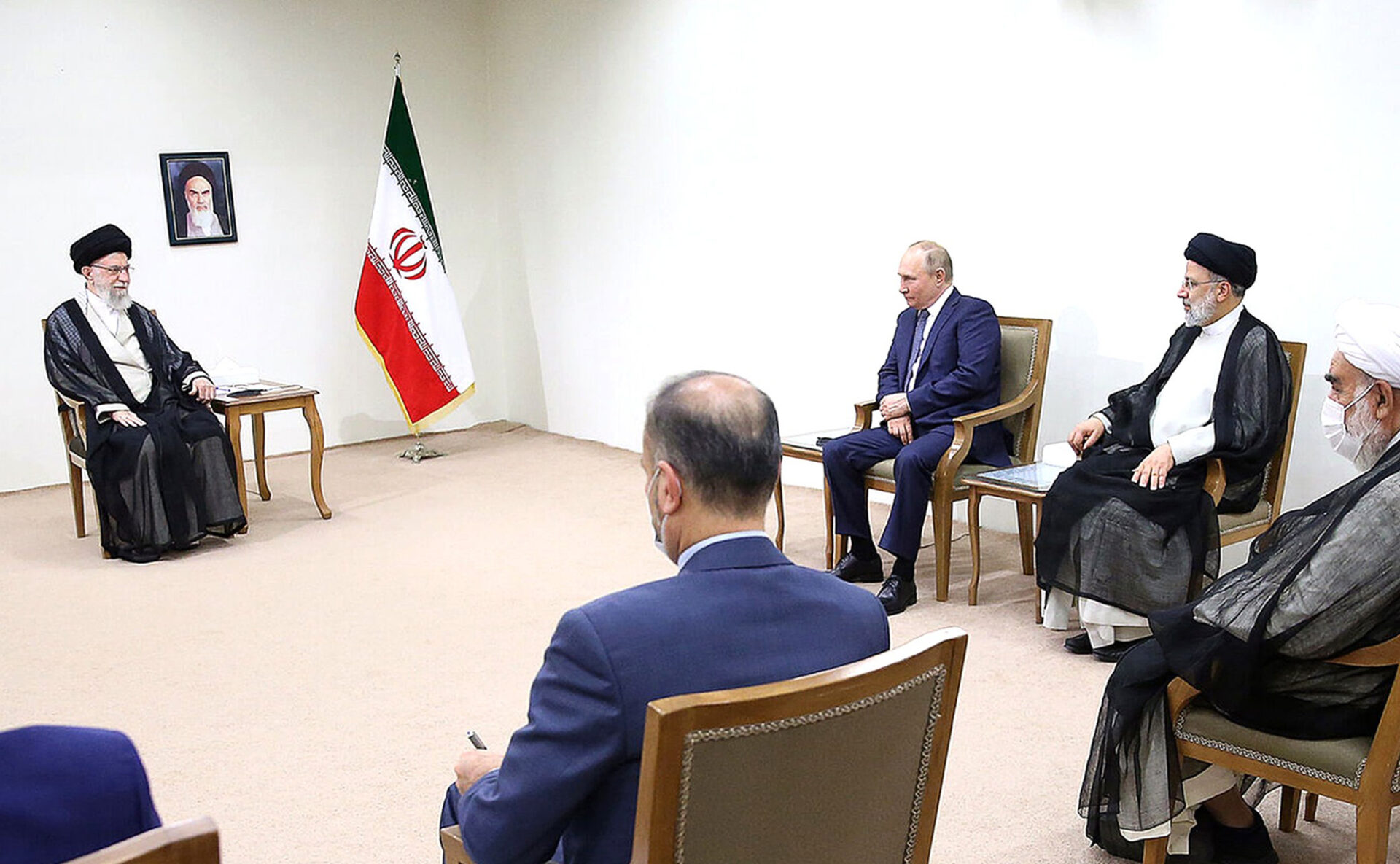According to the French geopolitologist, the Russian-Iranian alliance is strengthening against the backdrop of the war in Ukraine, and Iran could become a platform for circumventing the geo-economic measures taken against Russia.
At this time, it is not clear that the Iranian nuclear agreement will be renewed, as negotiations are stalling over the inspection of secret sites and new demands from Tehran. It is also certain that such an agreement would not resolve the substance of the issue, much less that of Iranian missiles or its subversive and destabilizing action, from the Arabian Gulf to the Eastern Mediterranean, not to mention Yemen and the Red Sea. In truth, this is not our purpose.
Certainly, it remains fashionable to deny the reality of a Russian-Iranian alliance. At most, the two countries would be linked by limited and conjunctural interests, against a background of fundamental historical divergences, as if history were only an eternal return of the same. And the doxa says that Russia would have an advantage in preventing Iran’s return to the oil and gas markets. On the contrary, observation of the facts highlights the strengthening of ties between Moscow and Tehran1.
The Russian-Iranian alliance
After initial approaches at the beginning of the post-Soviet period (the “anti-hegemonic coalitions” of Yevgeny Primakov), Russia and Iran concluded a strategic partnership in 2001. It took the form of important military-industrial contracts and civil nuclear cooperation that survived the international sanctions implemented under UN Security Council resolutions, with Moscow’s consent. Even before the 2015 nuclear deal was signed, Vladimir Putin was delivering S-300s to Iran and Russian generals were planning with their Iranian counterparts a military intervention in Syria, to the benefit of Bashar Al-Assad and the Baathist regime2.
In France, the Russian party and its “useful idiots” explained that Putin’s intervention would make it possible to fight Sunni jihadism, to replace the Syrian raïs with a more acceptable personality and to push back the Pasdarans (the Guardians of the Islamic Revolution) and the pan-Shiite militias dispatched to this theater by Teheran. In short, a martingale! In fact, the Iranian regime has been able to establish itself durably in Syria and build a “land bridge” (the “Shiite arc”) across the Middle East.
Despite the inevitable frictions and rivalries in the sharing of spoils, it is therefore a Russian-Iranian alliance that has taken shape on the ground, with combined operations between the Russian air force and the Iranian-Shiite ground forces. Since then, an intelligence and counter-intelligence pact has completed this alliance (2021). The redeployment of part of the Russian expeditionary force to the Ukrainian theater even opens up new fields of action for the Pasdarans, who are much more present in southern Syria, which worries Jordan as much as the State of Israel3.
Some would like to believe that the hypothetical return of Iran to the hydrocarbon market, after the possible signing of a new nuclear agreement, would worry Putin and his surrogates. Conversely, this return would increase the room for maneuver of the West, confronted with the energy war waged by Moscow (Nord Stream was supposed to be a commercial project: “Wandel durch Handel“!).
Seen from Moscow, the geopolitical stakes are global and go beyond the sole question of oil exports: Iran is a key link in the chain of revisionist and disruptive powers; the strengthening of ties with Tehran opens up broad prospects beyond the Middle East.
As for Shiite jihadism, it is not soluble in the black or white gold market. This is demonstrated by the relentless desire to develop a nuclear program, against Iranian economic interests. In this area, Barack Obama’s prognosis was based on a poor man’s philosophy of history, marked by economism (the axiomatics of interest).
Closer ties and expanded cooperation
During Putin’s visit to Tehran on July 19, Ayatollah Ali Khamenei, Supreme Leader of the Islamic Revolution, and his factotum, President Ebrahim Raissi, justified Russia’s military aggression in Ukraine and denounced NATO, which in Tehran is seen as the evil cause. The Kremlin’s propaganda is taken at face value, not out of any sense of conformity, but because it fits the ideological DNA of the Iranian regime and the millenarian vision of the men who monopolize power.
It was then learned that a new Russian-Iranian strategic agreement was being studied, with cooperation between the two capitals to include the spheres of banking and finance in the future4. Gazprom and the National Iranian Oil Company have already signed a contract for the development of Iranian hydrocarbon fields, worth $40 billion. Already envisaged in the 2000s, the project of an “OPEC of gas” is also back in the field5.
In the weeks that followed, the forms of this Russian-Iranian alliance became more pronounced. On 9 August, Russia launched from the Baikonur Cosmodrome in Kazakhstan a satellite manufactured by Iran (the Khayyam satellite). Theoretically intended for civilian use, this satellite probably has a military vocation6. According to some analyses, it could contribute to the Russian military effort in Ukraine (if there is still time).
In the same month, Jake Sullivan, security advisor to the President of the United States, informed us that the Russian government was planning to buy drones from Iran (Mohajer and/or Shahed drones). From 29 August, planes flew these devices to Russia, their deficiencies and the necessary adaptation to the Russian military system explaining why they have not yet been observed on the battlefield7. Since then, Iranian leaders have admitted that they are considering the purchase of Su-35 fighter jets (see the words of the head of the Iranian Air Force, General Hamid Vahedi).
However, the main issue is elsewhere. In the case of a new nuclear agreement with Iran, the lifting of the sanctions and limitations that hamper the country’s economic and financial apparatus, which is under the control of the Pasdarans and the Islamic foundations, would constitute a windfall for Russia. Putin and his followers could use Iranian territory as a platform for circumventing Western geo-economic measures, with the Iranian ally also providing undeniable know-how in this area8.
Putinism: an Asianism
The tightening of the Russian-Iranian alliance is part of a broader perspective, that of a bloc of revisionist and disruptive powers in the Old World. On the horizon is the tilting towards the East and the emergence of a world centered on the Sino-Russian axis. At the very least, this is Putin’s geopolitical scheme, which he explained at the Eastern Economic Forum (EEF) in Vladivostok on 7 September9. This speech is in line with the theses of Alexander Dugin, the popularizer of Eurasism in Russian military-security circles.
Regardless of the fact that a new version of the 2015 nuclear agreement would not be an adequate response to the Iranian threat and the risk of a cascade of proliferation10, it is possible that the Biden Administration will be led to quickly put sanctions back in place in order to enforce the measures taken against Russia. There would then be no shortage of “realists” and tyrannical thurifers to cry out about American inconstancy.
All this remains hypothetical (nothing is signed) but it is important to take into account the different facets of the Iranian “case” and to anticipate the consequences of such an agreement. Without forgetting that a Russian defeat in Ukraine and the geopolitical shock it would provoke would also be an object lesson for Iran and its main client, the “great disrupter” China. This is not impossible. It is even within reach. So many reasons not to give up, on the Iranian nuclear issue as well as in Ukraine and in the Taiwan Strait.
Associate professor of history and geography and researcher at the French Institute of Geopolitics (University of Paris VIII). Author of several books, he works within the Thomas More Institute on geopolitical and defense issues in Europe. His research areas cover the Baltic-Black Sea region, post-Soviet Eurasia, and the Mediterranean.
Footnotes
- See Jean-Sylvestre Mongrenier, “Une mise en perspective de l’alliance russo-iranienne”, Desk-Russie, 1 July 2021
- Concluded in 2007, the Russian-Iranian contract on the S-300 was suspended three years later by the Russian president at the time, Dmitri Medvedev, who was convinced of the need to put pressure on the Iranian regime in order to halt the march towards a warlike atom.
- In order to evade Israeli strikes, the Pasdaran put on Syrian army uniforms.
- Note here the Russian project to develop new world reserve currencies and a Sino-Russian international payment system. The Kremlin would also like to found a precious metals exchange, the Moscow World Standard, capable of competing with the London Bullion Market Association.
- The success of “OPEC +” — the energy oligopoly that brings together OPEC, Russia and a few other oil producers — and its ability to influence the world oil market are reasons to take seriously the Russian-Iranian project of an “OPEC of gas”. In this respect, it is important that an effort to repress Iranian ambitions in the Middle East and explicit support for an Israeli-Sunni alliance (see the Abraham Accords) be accompanied by greater firmness on the part of the Western powers with regard to their regional allies and their strategic ambiguity towards Russia and China.
- The Khayyam satellite has a linear resolution of 0.73 meters, which multiplies Iran’s capabilities by ten and gives it a certain autonomy in surveillance. These performances are far from those of Western satellites, but in the case of Iran, they mark the crossing of a new technical-military threshold.
- Because of these deliveries of Iranian drones to Russia, the Biden Administration has decided to apply new sanctions against the Pasdaran and the Iranian companies involved in these exchanges.
- On the scope and effects of the closer ties between Moscow and Tehran, see Matthew Luxmoore, “Grain, drones and satellites: Iran and Russia forge closer ties,” The Wall Street Journal (in L’Opinion), 30 August 2022.
- With its focus on anti-Westernism, “de-dollarization” and “multipolarity”, the seventh edition of the EEF has taken on the appearance of an anti-sanctions club and a hotbed of Asianism. In addition to the importance of People’s China in Putin’s geopolitics — trade and exports of electronic components are crucial for Russia-Eurasia — one should note the strengthening of ties with North Korea, a “bunker-regime” whose exports of Soviet-made shells and ammunition are supposed to alleviate the difficulties of the Russian military-industrial complex.
- If Iran is allowed to enrich uranium, which the 2015 agreement provides for, why not Saudi Arabia and Turkey? The question is not rhetorical: words in this direction are being said in Riyadh and Ankara, and even in Abu-Dhabi. And experience teaches us that there is no watertight partition between the civilian use of nuclear energy and its military applications.




